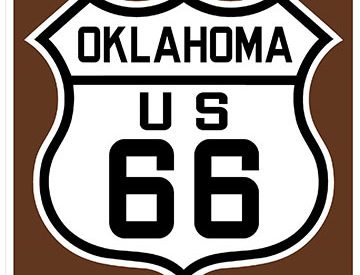New Signs point the way to Route 66 in Oklahoma
Mike Seals - March 15, 2021 11:12 am

Mid-March marks 75 years since Nat King Cole recorded what would become the definitive song for people to “(Get Your Kicks On) Route 66.” These days, travelers and Route 66 enthusiasts who “plan to motor west” will have an easier way to spot the Mother Road in Oklahoma. Revised historical route markers are going up over the next few months along key areas as one of the first visual cues that the state is getting ready for the upcoming Route 66 centennial celebrations in 2026.
The new design is the result of input from Lt. Gov. Matt Pinnell, who is also the state’s Secretary of Tourism & Branding, the Oklahoma Route 66 Centennial Commission, the Oklahoma Historical Society, the Oklahoma Route 66 Association, the Route 66 Alliance and the Oklahoma Department of Transportation.
“Travelling on Route 66 and seeing the incredible history of this highway in person is a destination trip for people worldwide, and we are so incredibly fortunate to have this gem right here in our state,” Pinnell said. “These signs will help drivers easily identify areas of the Mother Road and bring new awareness to this transportation treasure in Oklahoma.”
The signs have a brown background which is used nationally to designate areas of cultural significance. The words “historic” and “route” will be in white letters, which is a change from the current design that uses black lettering. A historic font pays homage to the early version of the signs and the recognizable US-66 shield is featured.
“Oklahoma has more drivable miles of Route 66 than any other state, making it an easily accessible historic destination which will showcase the signs all around our state,” Oklahoma Secretary of Transportation Tim Gatz said. “These signs are a low-cost project that will have a major impact for everyone wanting to see what makes Route 66 so special.”
The original path of Route 66 traverses present-day highways, interstates and also local roads across the state. ODOT will continue to work with local communities who have an interest in placing signs along sections of the route along their city streets. Sign templates are already being made available to those cities wishing to partner in this centennial effort so they can create matching signs, and ongoing conversations will continue to help address route gaps and also how the sign initiative can help highlight the unique aspects of the route on local roads.
For the highway and interstate system statewide, ODOT has produced nearly 400 of the updated historical route markers in-house at a cost of about $50 per sign for an estimated up to $20,000 total. Over time, these will be either replace older markers or also placed at additional locations to help point the way to local segments of the route.
Adjustments will continue to be made in this initial phase of signing the highway system. As the route also doubled in some areas between adjacent interstates and highways, the marker locations will be refined to point the way to secondary routes so that travelers can see what makes historic Route 66 in Oklahoma City… and the entire state of Oklahoma… “so pretty.”
For more information on historic Route 66, visit the Oklahoma Route 66 Association website at oklahomaroute66.com and also the Route 66 Alliance Facebook page at https://www.facebook.com/route66alliance/ for more information on Route 66 and the upcoming Centennial.
Key facts about historic Route 66:
- Originally designated as U.S. Highway 66, the road stretched from Chicago through Missouri, Kansas, Oklahoma, Texas, New Mexico, Arizona and California, ending in Santa Monica.
- Route 66 was one of several national highways established in 1926 and originally covered a total of nearly 2,500 miles.
- Cyrus Avery, then-chairman of the State Highway Commission in Oklahoma, was known as the “Father of Route 66,” having helped create the first U.S. highway system.
- Known as “America’s Main Street” or “The Mother Road,” the route ran through Oklahoma and served as the state’s first major east-west highway.
- Oklahoma has more drivable miles of Route 66 than other states; 400 miles of the Mother Road stretch from Quapaw in northeast Oklahoma to Texola in western Oklahoma, with many historic and roadside attractions remaining along the route.
- The official Route 66 designation was nationally removed from the highway system in 1985.
- Historic Route 66 is designated as a Scenic Byway and also gained designation as an All-American Road in 2008 from the Federal Highway Administration.




